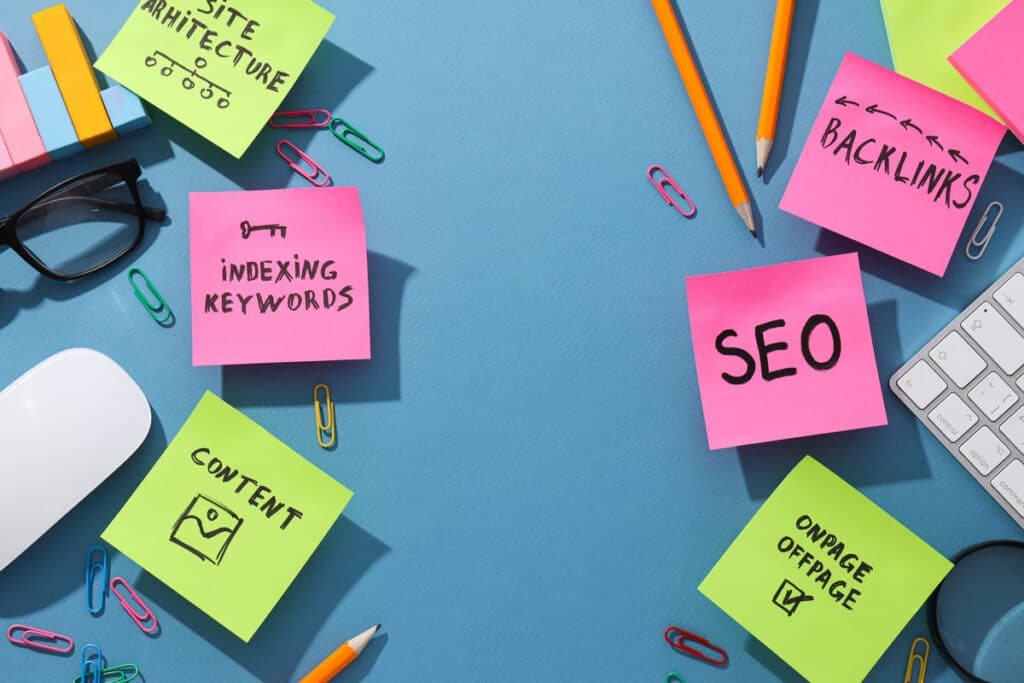Search Engine Optimization (SEO) makes your content visible to the right people. It helps websites rank higher on search engines. But SEO can take a lot of time and effort to manage.
AI for SEO helps save time and improve results. It handles tasks such as finding keywords, checking trends, improving your content and lots more things.
A recent survey found that more than 60% of marketers say using AI tools has improved their SEO efforts.
Think of it as a personal assistant. It looks at data and finds ways to help your website perform better. This shows how AI is becoming a vital tool in digital marketing.
This article will show you how to use AI for SEO step by step. You will learn how AI can improve your rankings, enhance your SEO practices with AI, and avoid common mistakes. The steps are simple and easy to follow.
What is AI SEO?
AI SEO means using artificial intelligence to make SEO tasks easier. It helps your website rank higher in search results. This makes it easier for people to find your site. AI tools work quickly and save you time by handling repetitive tasks.
These tools process data and suggest ways to improve your website. For example, they can:
- Analyze your competitors’ websites to learn what works for them.
- Spot problems like slow-loading pages or broken links.
- Generate fresh content ideas and detailed outline
- Analyze content marketing data to show what’s performing well.
- Suggest better meta descriptions that attract clicks.
AI platforms like Semrush and Surfer SEO help you find the right keywords. They also show what topics your audience wants to read. Tools like Frase and MarketMuse suggest trends and help you create content that ranks better.
AI doesn’t replace your work. Instead, it supports you by automating tedious tasks and offering helpful insights. This gives you more time to focus on creating great content. No matter your experience level, AI tools help improve your site’s performance and bring in more visitors.
Why Use AI for SEO?
Managing SEO can be challenging with so many tasks to handle. From finding keywords to fixing website issues, it can take a lot of time and effort. This is where AI can make things easier.
AI tools work like a helping hand for SEO. They handle repetitive tasks and offer insights to improve your website. With AI, you save time and focus on what matters most.
Here are some reasons to use AI for SEO:
Save Time and Work Smarter
AI takes care of time-consuming tasks like keyword research and analyzing content. This means you can focus on creative strategies instead.
- Stat: 37% of marketers use AI to save time and improve efficiency.
Make Better Decisions with Data
AI reviews large amounts of data to show trends and patterns. It highlights what works and what needs improvement.
- Stat: Businesses using AI report a 2x improvement in decision-making speed.
Create High-Quality Content
AI tools suggest topics based on what people are searching for. This helps you write content your audience wants to read.
- Stat: Companies using AI-driven content strategies see a 45% boost in organic traffic.
Stay Ahead of Competitors
AI shows what your competitors are doing well and how you can improve. This insight helps you create better strategies and stay competitive.
- Stat: 38% of businesses use AI to track competitors and improve their plans.
Fix Site Issues Quickly
AI identifies problems like slow-loading pages or broken links. Fixing these issues improves user experience and boosts your search rankings.
- Stat: Pages that load faster can boost conversions by 20%.
A small e-commerce store used AI tools to refine its SEO strategy. The tools suggested new keywords, fixed technical issues, and optimized product descriptions. Within six months, the store saw a 30% improvement in search rankings and an increase in sales.
AI is rapidly becoming essential for businesses. In 2024, the global AI market was valued at $184 billion, growing by nearly $50 billion in just one year. By 2030, it’s expected to reach $826 billion, showing how more businesses are using AI to succeed.

How to Use AI for SEO Effectively?
AI is now a must-have tool for SEOs and content marketers. It simplifies complicated tasks, improves efficiency, and delivers better results. Whether it’s finding the right keywords or analyzing backlinks, AI can transform your SEO strategy.
Let’s dive into how AI can make your SEO smarter, faster, and more effective.
Here are eight practical ways to use AI for SEO:
1. Find the Best Keywords
Finding the right keywords is one of the most important parts of SEO. Keywords are the words people type into search engines to find what they need. Using the right keywords helps your website appear in search results and reach the right people.
AI tools make keyword research quick and easy. They look at:
- Search Volume: How many people search for the keyword.
- Competition: How hard it is to rank for the keyword.
- Relevance: How well the keyword fits your website or topic.
These tools analyze a lot of data to suggest keywords that can improve your rankings.
For example, you can use ChatGPT to ask:
“What are some easy-to-rank keywords for a baking blog?”
In seconds, you’ll get a list of keyword ideas like “simple cake recipes” or “quick baking tips.”
Once you have these keywords, tools like Semrush or Ahrefs can help you decide which ones to use. These tools show details like how often the keyword is searched, how competitive it is, and whether it matches your content.
For example, An online store selling handmade jewelry used AI to find keywords like “unique handmade rings” and “custom necklaces under $50.” By optimizing their content with these keywords, they saw a 40% increase in organic traffic in just three months.
Using AI tools saves you hours of manual work. They help you focus on the keywords that bring real results, so you can spend more time creating great content and growing your website.
2. Plan Content That Works
Creating or improving content to perform well in search results is essential. Content is what your audience reads, watches, or listens to when they visit your website. AI tools simplify this process by identifying gaps, finding trends, and structuring content.
AI tools can help you with content tasks:
Find Topics People Care About
AI tools like Frase help you discover trending topics. They analyze search data and show what people are searching for right now.
For example, a fitness blog used Frase to find questions like “How can I lose weight without dieting?” By writing articles on these questions, the blog increased traffic by 45% in two months.
AI also uses Google Autocomplete and People Also Asked to suggest related terms. If you type “quick meal ideas” into Google, you might see results like “easy 5-minute recipes” or “healthy dinner plans.” These suggestions guide you to create content that matches what your audience wants.
Make Content That Solves Problems
AI tools ensure your content answers user questions. Tools like BrightEdge analyze competitors’ content and find gaps you can fill.
For example, if many blogs about gardening skip over “tools for small gardens,” BrightEdge will show you this opportunity. Writing about these overlooked topics improves your content’s relevance and rankings.
When your content solves real problems, people stay longer on your site. This builds trust and makes them more likely to return.
Organize Your Content Better
How you organize your content matters. AI tools like Surfer SEO recommend the best layout for your articles. They tell you:
- How many headings to use.
- Ideal word counts.
- Sections to include.
For example, a tech website used Surfer SEO to improve its blog layout. The site lowered its bounce rate by 20% by adding subheadings and breaking long paragraphs into shorter ones.
A well-structured article is easier to read and keeps people on your site longer.
Keep Content Fresh
Old articles can lose value over time. Tools like Semrush Copilot identify which posts are underperforming. They suggest updates like adding new keywords, improving headlines, or expanding sections.
For instance, a small business refreshed its old posts using Copilot. They optimized keywords and updated information. This led to a 35% increase in traffic within two months. Keeping content fresh ensures it stays relevant and continues to rank.
Improve Keywords with NLP and NGrams
AI tools use Natural Language Processing (NLP) to understand how people search. They find popular word combinations, called NGrams, that users type into search engines.
For example, instead of just “baking,” an AI tool might suggest “easy baking tips” or “baking for beginners.”
These keyword combinations make your content match what users are searching for. This improves your visibility and rankings.
Make Content Easy to Read
Readable content keeps people engaged. Tools like HemingwayApp highlight long sentences and suggest simpler alternatives.
A food blog used HemingwayApp to rewrite its recipes with shorter steps. This made the content easier to follow and reduced bounce rates by 15%.
When your content is easy to read, people stay longer and are more likely to share it.
Spot Gaps and Build Topic Clusters
AI tools like MarketMuse help you find gaps in your content. If gardening blogs only talk about soil types, you can write articles about planting schedules to fill the gap.
AI also helps you link related articles together into topic clusters. These clusters improve your SEO by showing search engines your content is well-organized.
With AI tools, creating content isn’t just about posting—it’s about making something helpful and relevant. They help you:
- Spot content gaps.
- Create topic clusters that answer questions.
- Optimize keywords and ensure your content aligns with Google’s E.E.A.T. guidelines.
AI ensures your content meets user needs and keeps you ahead in rankings. By using tools like Frase, BrightEdge, MarketMuse, Semrush, and Surfer SEO, you can create content that is engaging and performs well.

3. Make On-Page SEO Better
Improving on-page SEO helps your website rank higher and keeps visitors happy. AI tools make this process simple. They help you update key areas like meta tags, headers, URLs, page speed, and user experience.
Meta Tags Optimization
Meta tags tell search engines and users about your page. Title tags and descriptions are key for getting clicks. AI tools like Semrush and ChatGPT help you write meta tags with the right keywords.
A local bakery used Semrush to add “fresh bread near me” to their meta tags. This small change brought them a 15% increase in clicks in one month. Well-written meta tags are easy to add and can improve your site quickly.
Structure Header Tags
Header tags such as H1 and H2 organize your content and make it easy to read. They also help search engines understand your page. AI tools like Surfer SEO suggest the best places to add headers.
A travel blog improved their article “Europe Travel Tips” with headers like “Budget Destinations” and “Packing Tips.” This change reduced their bounce rate by 18%. Clear headers make your content more engaging for readers and search engines.
URL Silo
A silo structure groups related pages together. It makes your site easier to navigate and improves search engine crawling. AI tools like Screaming Frog find issues in your URLs and suggest fixes.
An online store selling electronics grouped products into silos like “Laptops” and “Smartphones.” This change boosted their organic traffic by 25%. Clear URLs help visitors find what they need faster.
Speed Up Your Page
Fast pages keep visitors on your site. Slow-loading pages frustrate users and lower rankings. AI tools like Google PageSpeed Insights find ways to make your pages load faster.
A clothing store reduced its image sizes and cut loading time by 2 seconds. This simple fix boosted sales by 22%. Faster pages make visitors happy and improve search rankings.
Enhance User Experience (UX)
A user-friendly website is easy to navigate, loads fast, and works on mobile. AI tools like Market Brew give tips to improve your site’s design.
A non-profit made their donation page easier to use on mobile. After the update, donations went up by 28%. Good user experience makes visitors stay longer and return more often.
Making small updates to your website improves both rankings and user satisfaction. AI tools like Semrush, Surfer SEO, and Google PageSpeed Insights help you do this quickly.
Optimizing meta tags, headers, URLs, and page speed creates a better experience for visitors and search engines.
4. Add Schema to Your Website
Schema markup helps search engines understand your website’s content. It adds extra details to your pages, such as star ratings, prices, or FAQs.
These details appear as “rich results” in search engines, making your pages more noticeable and clickable.
Schema is a small piece of code added to your website. It gives search engines specific details about your content. For example, a recipe schema shows cooking steps, ingredients, and prep time.
Imagine searching for “chocolate chip cookie recipe.” A result with schema might display a 4.5-star rating, prep time, and reviews directly on the search page. This makes the result more useful to users.
Common Types of Schema
Search engines support over 30 schema types, including:
- Recipes
- Events
- How-to guides
- Products
An event planner used schema to showcase details about an upcoming concert. The schema displayed the event date, time, and ticket prices in search results. This small update led to a 20% increase in ticket sales.
AI Tools Make Schema Easy
Manually creating schema can feel complicated because it involves coding. Thankfully, AI tools make the process fast and simple. They create ready-to-use schema code that you can paste into your website.
Here are some helpful tools:
- Jasper’s FAQ Schema Generator: Creates schema for FAQs.
- Merkle’s Schema Generator: Builds schema for products and events.
- RankRanger Schema Builder: Provides templates for structured data.
Schema makes your content easier for search engines to understand. Rich results with extra details help your website stand out and get more clicks.
For example, a restaurant used a schema to display their menu, prices, and hours in search results. This led to a 25% rise in reservations in just one month. Schema makes your site more helpful for users and improves search rankings.
Schema markup is a powerful way to improve your website. AI tools like Jasper, Merkle, and RankRanger make it easy for anyone, even beginners.
5. Check What Competitors Do
Want to stay ahead of your competitors? AI tools make it easy. They collect data from websites, social media, and reviews to show what works for others. This helps you improve your strategy and find new opportunities.
Here are some key things AI tools can help you understand:
- Keywords They Use: AI tools reveal the words your competitors rank for on search engines. Use this to find new ideas for your content strategy.
- Content They Create: Discover the types of blogs, videos, or social media posts your competitors use. This shows what connects with their audience and sparks ideas for your content.
- Social Media Activity: Learn how often competitors post and which posts get the most likes, comments, or shares.
- Who Links to Them: Find websites that link to your competitors. Reach out to these websites to grow your network and build authority.
- Customer Opinions: Check reviews and comments to see what people say about competitors. This shows what customers like or dislike about their products or services.
- Industry Trends: Track what’s trending in your industry by watching what competitors do well.
Tools That Can Help
Here are some tools that help you gather and analyze competitor data:
- Ahrefs: Reveals keywords and top-ranking pages.
- Semrush: Provides in-depth competitor analysis, including SEO audits.
- BuzzSumo: Shows which social media content performs best.
- Crayon: Tracks updates on competitor websites.
- Sprout Social: Monitors competitor social media engagement.
- Google Alerts: Notifies you when competitors are mentioned online.
AI tools give you clear insights of your competitors. For example, a bakery used BuzzSumo to find out which posts worked well for competitors. They noticed vegan dessert posts were trending, added vegan options to their menu, and boosted sales by 30%.
They help you create smarter SEO strategies, find content gaps, and stay ahead of trends. Also make competitor research fast and effective, giving you the edge to grow your business.
6. Automate SEO Technical Checks
Technical SEO makes your website easy for search engines to understand. It ensures your site is fast, error-free, and works well on all devices. This helps search engines rank your site higher. It also gives users a better experience.
Imagine a slow website with broken links. Visitors leave quickly, and search engines rank it lower. A well-optimized website keeps users happy and brings more traffic.
Here are the key ways AI helps with technical SEO:
AI can handle many complex SEO tasks, making it faster and easier to keep your site in good shape. Here’s how it works:
- Site Structure: AI reviews how your site is built. It helps ensure everything is well-organized, which makes it easier for search engines and visitors to find what they’re looking for.
- Crawl and Index Problems: AI finds issues that stop search engines from reading your pages. Once fixed, search engines can crawl and index your site properly, leading to better rankings.
- Broken Links: Broken links can frustrate users and hurt SEO. AI quickly finds these so you can fix them.
- Duplicate URLs: Sometimes your site might have different URLs that show the same page. AI identifies these duplicates so you can fix them and avoid confusing search engines.
- Code Errors: AI looks for mistakes in your site’s code that can cause slowdowns or make your site harder to use. By fixing these, your site runs more smoothly.
- Canonical Tags: Canonical tags tell search engines which version of a page is the main one. AI ensures these tags are set up correctly, so you don’t end up with duplicate content penalties.
- Language Tags: If your site serves different languages or regions, AI checks your hreflang tags. These tags help search engines show the right content to the right audience.
- Internal Links: Internal links connect your pages to each other. AI makes sure these links work well and suggests improvements, so both users and search engines can navigate better.
- Clean URLs: AI checks if your page addresses are simple and clear. For example, it helps you use “/about-us” instead of “/page123.”
- Better Mobile Experience: Mobile traffic is huge, so AI ensures your site looks and works great on phones and tablets.
AI Tools That Help Automate Technical SEO
Here are some of the best tools for automating technical SEO:
- Screaming Frog SEO Spider: This tool scans your website for broken links, duplicate content, and other issues. It’s fast, reliable, and widely used by SEO experts.
- DeepCrawl: DeepCrawl checks your site’s structure and finds technical problems. It helps ensure your website is easy to navigate and crawl.
- Surfer SEO: Surfer SEO analyzes top-ranking pages. It suggests changes to improve your content and make it more competitive.
- Moz Pro: Moz Pro tracks your site’s performance, finds technical issues, and helps with keyword research.
Using AI for technical SEO gives you many benefits:
- Improves Site Speed: AI helps you make your site faster. Fast-loading websites rank higher and keep users happy.
- Reduces Errors: AI tools are accurate and consistent. They spot problems that humans might miss.
- Boosts Rankings: Fixing technical issues helps your site rank higher in search results.
- Enhances User Experience: A well-functioning website is easier to use. Visitors stay longer, which improves your SEO.
A business used RaptorScan to fix broken links and improve their site’s speed. Within a month, their organic traffic increased by 30%.
AI helps you fix problems, improve performance, and rank higher in search results. Using AI tools to automate technical SEO tasks ensures that your site stays in top shape without the need for constant manual checks.
7. Fix and Link Pages Internally
Internal links connect one page of your site to another page. These links help visitors find related content. Proper internal linking also spreads “link equity.” They also help search engines figure out which pages are most important.
Manually managing internal links takes time and can lead to mistakes. AI tools simplify the process by:
- Analyzing Content: AI scans your site to see what each page is about.
- Finding Links: It suggests where you should add links to connect related pages.
- Adding Links: Some AI tools can add these links automatically.
Using AI for internal linking offers several advantages:
- Better User Navigation: People can find helpful content more easily.
- Improved SEO Performance: Proper linking helps search engines rank your pages more effectively.
- Time Efficiency: AI handles repetitive tasks, letting you focus on creating content.
Top AI Tools for Internal Linking
Here are some AI-driven tools that can assist with internal linking:
Link Whisper: An AI-powered WordPress plugin. That suggests relevant internal links as you write, reducing the linking process.
- LinkRobot: Places links intelligently by understanding your site’s content.
- LinkScout: Helps structure your links for better SEO and user experience.
- Semrush: Known for keyword research, Semrush’s internal linking tool uses AI to identify the best link opportunities.
- LinkStorm: Offers quick suggestions to improve your site’s internal links..
A blog used an AI tool for internal linking and saw visitors spend 25% more time on the site. This improved both the user experience and SEO rankings.
Good internal linking makes it easier for visitors to explore your site. It also shows search engines which pages are most important.
8. Review and Improve Backlinks
Backlinks are links from other websites that point to your site. They help Google see that your content is useful and important. When good websites link to your content, it can make your pages rank higher. This can bring more people to your site and improve how Google views your pages.
AI tools simplify the process of managing backlinks. They can quickly check the quality of the links pointing to your site, helping you find which ones help your ranking and which ones might hurt it. AI tools also helps locate sites that might link to your content.
By watching your backlinks over time. AI tools ensures that your backlink profile stays strong and helps your site perform better in search results.
Top AI Tools for Backlinks
There are several easy-to-use tools that can help:
- Ahrefs: Known for its large backlink database, Ahrefs uses AI to check your links and show ways to improve.
- Moz Pro: Moz’s AI tools find bad links, track your site’s progress, and suggest ways to make it better.
- SEMrush: SEMrush helps you understand your backlinks and provides simple ideas on what works and what doesn’t.
- Linkody: This tool alerts you if a link is lost or changed, and offers clear advice on how to keep your profile healthy.
- BuzzStream: BuzzStream helps you reach out to others and suggests new links that could benefit your site.
When you use AI tools for backlinks, they can save you hours of manual work. An AI tool can automatically scan hundreds of links to find which ones are helping your rankings. This helps you focus on building the links that matter most.
AI also makes it easier to avoid links that can hurt your site. A study by Backlinko showed that removing harmful links helped one site improve its search ranking by 20%. By cleaning up poor-quality links, AI ensures your site stays in good standing with search engines.
It also allows you to track your progress. Over time, you’ll see how your backlink profile grows and which strategies work best. A digital marketing company used Ahrefs to track their link profile growth over time.
Best Practices for Combining AI and SEO:
Combining AI with SEO makes your strategy smarter and more efficient. AI tools can analyze large amounts of data, find trends, and suggest strategies faster than a person ever could. According to McKinsey companies that use AI in their workflows are 40% more likely to surpass competitors.
AI helps with keyword research, content creation, and fixing SEO errors. But to get the best results, you need to use AI in the right way. Here are some best practices to follow.
1. Set Clear Goals Before Using AI
To get the most out of AI, start with clear goals. Are you trying to improve your website traffic? Fix errors? Find better keywords? Knowing your goal will help you choose the right tools.
- If you want to find better keywords, use tools like SEMrush or Ahrefs.
- If you need to fix broken links or crawl errors, try DeepCrawl.
Without a clear goal, you might waste time using tools that do not meet with your needs. A business using SEMrush for keyword research improved its organic traffic by 35% because they knew what they wanted to achieve.
2. Balance AI Tools with Human Editing
AI is great at generating content, but it’s not perfect. Tools like Jasper AI or ChatGPT can write blog posts, but the content needs human editing to ensure quality. Google’s Helpful Content Update in 2023 penalized websites with low-quality, AI-generated text that didn’t help users.
An online store used ChatGPT to create product descriptions. They edited the AI drafts to make them unique and engaging. This small step increased their sales by 30%.
AI-generated text generally misses creativity, or specific details about your audience. By combining AI insights with human expertise, you can create content that stands out.
Search Engine Journal found that websites relying heavily on unedited AI content saw a 20% drop in rankings after Google’s update.
3. Use AI to Create a Better User Experience
AI tools doesn’t just help with content. It can also improve how users interact with your site. Tools like Hotjar and Google Analytics 4 can show you how visitors go through your pages. AI analyzes this data to suggest improvements.
If many users leave a page quickly, these tools can identify the problem—like slow load times or confusing layouts. Fixing these issues can increase visitor time on your site. Research by HubSpot shows that websites offering a good user experience see 55% more traffic than those that don’t.
A better user experience means happier visitors. Happier visitors are more likely to convert into customers.
4. Stay Updated with AI and SEO Trends
AI and SEO are changing all the time. New tools are released, and search engines frequently update their algorithms. Staying informed helps you adjust your strategy before competitors catch up.
Voice search is becoming more popular. By 2025, 50% of all searches are expected to be voice-based. AI tools like SEMrush help you optimize for conversational keywords, ensuring your content is ready for this shift.
5. Test AI Suggestions Before Fully Implementing Them
AI tools often provide great ideas, but not all suggestions will work for your audience. Always test AI-driven changes before applying them to your complete site. Use A/B testing to compare results.
A blog uses AI to create different headlines for the same post. After testing, they found one headline that improved click-through rates by 25%. Testing allowed them to pick the option that worked best.
Testing ensures that the changes you make are effective. It also gives you data to refine your strategies over time.
6. Focus on Content That Helps Users
AI tools like Frase or AnswerThePublic can help you discover what your audience is searching for. Use this information to create content that answers their questions.
Google prioritizes content that meets user intent. HubSpot found that blogs answering specific questions generate 55% more traffic.
A cooking website used Frase to find trending topics. They created content based on the most common questions, like “How to bake without eggs.” This strategy doubled their organic traffic in three months.
AI and SEO are powerful when used together. AI improves efficiency, while human creativity ensures quality and originality. By setting clear goals, balancing AI with human creation, and staying updated on trends, you can create strategies. That attract more visitors and deliver better results.

Common Mistakes to Avoid When Using AI for SEO?
Using AI for SEO can help you improve your website and get more people to visit it. But, there are some common mistakes you should avoid to make sure you get the best results. Let’s take a look at these mistakes and how to avoid them.
1. Not Understanding What AI Can and Can’t Do
AI is a powerful tool, but it’s not perfect. Some people believe that AI can do everything for SEO, like writing great articles and fixing your website all by itself. However, this isn’t true. AI can help by giving suggestions and analyzing data, but it still needs human help to make important decisions.
Imagine you’re using AI to help you write a blog post. While AI can give you ideas and help organize the content, you still need to check if the article is useful and engaging for your audience.
According to a study by HubSpot, 55% of marketers say AI can improve efficiency. But it still takes human creativity to make the content truly effective. Don’t rely 100% on AI—use it to help you, but always double-check the results with your knowledge and experience.
2. Using the Wrong AI Tools
Not all AI tools are the same, and choosing the wrong one can waste your time and money. If you use an AI tool meant for writing blog posts to do technical SEO tasks (like checking your website’s speed), it won’t work well. There are specific tools for different SEO tasks, and using the right one is important.
Think of it like this: You wouldn’t use a spoon to chop vegetables, right? Similarly, use the right AI tool for each task. According to Search Engine Journal, picking the right AI tools for SEO can save businesses up to 30% in costs and time!
Always research and choose the right AI tools for each task. Like using a keyword tool such as SEMrush, or Aherfs to find search terms and a content tool Jasper or ChatGpt to help with blog writing.
3. Focusing on Quantity, Not Quality
It can be easy to create lots of content using AI to get your website noticed. But search engines like Google don’t care about how many pages you have—they care about how useful and relevant the content is. Writing tons of articles that don’t answer users’ questions won’t help.
Imagine searching for “best pizza places near me.” You’d prefer to see a list of the top-rated pizza restaurants, not just a long list of random places.
Focus on writing helpful, informative, and interesting content. It’s better to have fewer high-quality posts than many low-quality ones.
4. Forgetting to Keep an Eye on Your Results
SEO is always changing. Search engines update their rules, and user behavior changes. AI can help improve your SEO, but you need to keep checking your results to make sure your strategy is still working.
Google makes updates to its search algorithm almost every day. If you don’t keep track of how things are going, your website might stop showing up in searches.
A recent study shows that 70% of SEO campaigns fail because businesses don’t keep track of their performance over time. Regularly check your SEO results, like traffic and rankings, and make changes as needed.
5. Not Following Data Privacy Rules
When you use AI, you’re working with data. Some of this data may include personal information, and if you don’t handle it carefully, you could get in trouble. Laws like GDPR (in Europe) and CCPA (in California) protect people’s privacy, and if you break these rules, you could face big fines(penalities).
If an AI tool collects email addresses without asking for permission, this could be a violation of privacy laws. It’s important to make sure the AI tools you use follow these rules, or you might face penalties.
According to Forbes, data privacy violations can cost businesses millions of dollars. Always check that the AI tools you use are following privacy laws, and be careful with personal data.
6. Letting AI Do Everything Without Checking
While AI can help, it’s still important to check the work it does. Sometimes, AI can make mistakes, and if you don’t review its results, it could hurt your SEO efforts. In 2020, an AI tool misled people by writing an article about a fake Halloween parade in Dublin. If human have checked the article, it could have caused confusion and damage.
A Forbes article points out that businesses that rely too much on AI without human checks risk spreading wrong information. Use AI to help, but always double-check its work to make sure it’s accurate and helpful.
7. Giving AI Too General Instructions
To get the best results from AI, you need to tell it exactly what you want. If you give unclear instructions, like “Write a blog post about SEO,” the result might not be what you’re looking for.
For example, if you’re writing about SEO tips for beginners, tell the AI to focus on simple advice and include examples that are easy to understand.
Just like asking a friend to help you with a project, the more specific you are, the better the result. Moz research shows that clear, specific instructions help AI produce better content and avoid mistakes.
Be clear and specific with the instructions you give to AI tools, so they can create exactly what you need.
AI can be a great tool to help improve your SEO strategy, but it’s important to use it wisely. By understanding AI’s capabilities such as choosing the right tools, focusing on quality content, tracking results, following data rules, checking AI work, and giving clear instructions. You can avoid mistakes and get the best outcomes for your website.
Using AI the right way can increase traffic, save time, and improve your website’s performance. But it requires thoughtful planning and attention. Always keep learning and testing to make sure your AI tools are working for you, not against you!
Embrace AI for Smarter SEO and Stay Ahead of the Game
AI is changing the way we do SEO, making it quicker, easier, and more effective. By using AI tools the right way, you can save time, improve your rankings, and stay ahead of others. Keep in mind, AI is here to help you, not replace your own ideas and skills. With the right plans and a clear understanding of what AI can and can’t do, you’ll be able to build a strong SEO strategy that really works.
Remember, SEO is an ongoing process. Keep learning, keep testing, and always adjust your strategy as things change in the online world. By combining AI with what you already know, you’ll unlock the full power of SEO and take your website’s success to the next level.
Are you ready to improve your SEO with AI? Start today, and see how it can help!





